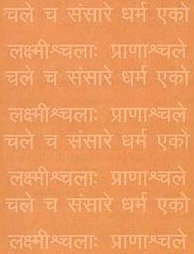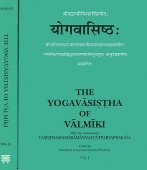Spanda, Spamda: 16 definitions
Introduction:
Spanda means something in Hinduism, Sanskrit. If you want to know the exact meaning, history, etymology or English translation of this term then check out the descriptions on this page. Add your comment or reference to a book if you want to contribute to this summary article.
In Hinduism
Shaktism (Shakta philosophy)
Source: Google Books: ManthanabhairavatantramSpanda (स्पन्द) refers to the “pulse” (of the supreme level of speech—parā vāc), according to Kṣemarāja in his commentaries on the Netratantra and the Svacchandabhairavatantra, which is well known to the Kubjikā Tantras.—‘Sound’ (nāda) is the name given to the pulse (spanda) of the supreme level of Speech (parā vāc), which animates the highest reality. The Netratantra refers to it as a form of sound that pervades the universe. Kṣemarāja explains that the energy of the higher levels initially manifests in two aspects. One is subjective, as the aggregate of the energies of Speech that function as the denotators (vācaka) of the second aspect, which consists of the aggregate of the energies of Speech, which they denote (vācya). When the initial impulse towards manifestation arises, the energy of consciousness retains the pulse of the second aspect within itself and expresses the pulse of the first aspect in the form of undifferentiated Sound. [...]

Shakta (शाक्त, śākta) or Shaktism (śāktism) represents a tradition of Hinduism where the Goddess (Devi) is revered and worshipped. Shakta literature includes a range of scriptures, including various Agamas and Tantras, although its roots may be traced back to the Vedas.
Vedanta (school of philosophy)
Source: Google Books: Studies on the MoksopayaSpanda (स्पन्द) refers to “movement”, according to the 10th century Mokṣopāya or Mokṣopāyaśāstra 6.182.13-17.—Accordingly, “With regard to each of [the three:] perceiver (draṣṭṛ), perception (darśana) and perceived objects (dṛśya), the state of mere knowledge is the essence; therefore there is not in the least a difference from it (i.e. knowledge), like a flower in space (is not different from space). (13) What is of the same kind becomes one. Therefore mutual perception [of things] determines their unity. (14) If wood, stones and other [material objects] did not have knowledge as their nature, then there would be a permanent non-perception of these, which would even be nonexistent. (15) When the whole beauty of perceptible objects has but one form of mere knowledge, then, whether it is different or identical, it becomes known through knowledge. (16) This whole [group of] perceptible objects in the world has expanded [as] mere knowledge, just as wind [i.e., vāyu] is mere movement [i.e., spanda-mātra] and the ocean mere water. (17)”.

Vedanta (वेदान्त, vedānta) refers to a school of orthodox Hindu philosophy (astika), drawing its subject-matter from the Upanishads. There are a number of sub-schools of Vedanta, however all of them expound on the basic teaching of the ultimate reality (brahman) and liberation (moksha) of the individual soul (atman).
Shaivism (Shaiva philosophy)
Source: Google Books: Manthanabhairavatantram (shaivism)Spanda (स्पन्द) refers to the “pulsation (of consciousness and vitality)”, according to the Mahānayaprakāśa by Arṇasiṃha (Cf. verse 182-197).—Accordingly, “The indestructible Skyfarer is the one whose body is the pulsation (spanda-deha) (of consciousness and vitality) which is the Supreme Self. His lord who is this (absolute) free of contact (with the phenomenal world) is said to be Khagendra”.
Source: SOAS University of London: Protective Rites in the Netra TantraSpanda (स्पन्द) or Spandarūpa refers to the “(universal) pulse (or throb)” [?], according to the Netratantroddyota commentary on the Netratantra of Kṣemarāja: a Śaiva text from the 9th century in which Śiva (Bhairava) teaches Pārvatī topics such as metaphysics, cosmology, and soteriology.—Accordingly, [verse 22.14]—“Praṇava is the universal pulse (spanda-rūpa—amānyaspandarūpaḥ) or throb that is unstruck, active ideation (verbalization that is not the result of contact with organs) which is like kalpa, the first acceptance of the cognition and action of all that is to be known and done for all living beings, because there could be no knowing and no doing without [praṇava]. [...]”.

Shaiva (शैव, śaiva) or Shaivism (śaivism) represents a tradition of Hinduism worshiping Shiva as the supreme being. Closely related to Shaktism, Shaiva literature includes a range of scriptures, including Tantras, while the root of this tradition may be traced back to the ancient Vedas.
Yoga (school of philosophy)
Source: ORA: Amanaska (king of all yogas): A Critical Edition and Annotated Translation by Jason BirchSpanda (स्पन्द) refers to the “movement (of the breath)”, according to the Haṭhapradīpikā of Svātmārāma: an influential 15th-century Sanskrit manual on Hatha-Yoga dealing with techniques to channel one’s vital energy.—Accordingly, while discussing methods for conquering the mind: “Acquiring spiritual knowledge, associating with the wise, abandoning habitual tendencies and stopping the movement of the breath (prāṇa-spanda); according to tradition, [all] these methods are effective in conquering the mind. The [mind] is quickly overcome by these [methods of restraint] like the dust of the earth by streams [of water]”.

Yoga is originally considered a branch of Hindu philosophy (astika), but both ancient and modern Yoga combine the physical, mental and spiritual. Yoga teaches various physical techniques also known as āsanas (postures), used for various purposes (eg., meditation, contemplation, relaxation).
Sports, Arts and Entertainment (wordly enjoyments)
Source: archive.org: Syainika Sastra of Rudradeva with English Translation (art)Spanda (स्पन्द) refers to the “motion (of standing crops)” (observed during hunting), according to the Śyainika-śāstra: a Sanskrit treatise dealing with the divisions and benefits of Hunting and Hawking, written by Rājā Rudradeva (or Candradeva) in possibly the 13th century.—Accordingly, “Hunting by watching the motion of standing crops is that in which animals are killed by the indication of the motion of wheat and other standing crops in which they hide themselves. In Sanskrit it is named Yāvaśī. This is ‘played’ by two or three horsemen who are expert archers. It is successful, if the advance is slow and the motion of standing crops (śasya-spanda) carefully observed. It doesn’t produce much fatigue, but it produces great excitement”.

This section covers the skills and profiencies of the Kalas (“performing arts”) and Shastras (“sciences”) involving ancient Indian traditions of sports, games, arts, entertainment, love-making and other means of wordly enjoyments. Traditionally these topics were dealt with in Sanskrit treatises explaing the philosophy and the justification of enjoying the pleasures of the senses.
Shaiva philosophy
Source: archive.org: Chittanubodha Shastram By Bhaskara KanthaSpanda (स्पन्द) refers to “vibration” or “vibrative consciousness” (which comes out of the blissful nature of the Absolute).—The Kashmir Śaiva thinkers believe in pluralism because not all human beings are alike and the different paths and Philosophies are meant for different kinds of people. [...] Unlike the Brahman of Advaita Vedānta which is not conscious of itself and inactive, the Supreme Reality here embraces in itself the static and the dynamic, knowledge and action. One of the central concepts of this school is spanda, vibration, which comes out of the blissful nature of the Absolute and makes for its dynamic and creative activity. The dynamism of the world flows from the very heart of vibrative Consciousness or spanda. This is also related to the conception of Śiva’s Śaktis or dynamic Energies. [...]
-
Languages of India and abroad
Sanskrit dictionary
Source: DDSA: The practical Sanskrit-English dictionarySpanda (स्पन्द).—[spand-ghañ]
1) Throbbing, palpitation.
2) Vibration, tremor, motion; मनो मन्दस्पन्दं बहिरपि चिरस्यापि विमृशन् (mano mandaspandaṃ bahirapi cirasyāpi vimṛśan) Bhartṛhari 3.51.
Derivable forms: spandaḥ (स्पन्दः).
Source: Cologne Digital Sanskrit Dictionaries: Shabda-Sagara Sanskrit-English DictionarySpanda (स्पन्द).—m.
(-ndaḥ) 1. Throbbing, throb. 2. Tremor, motion, vibration. E. spadi to shake, ghañ aff.
Source: Cologne Digital Sanskrit Dictionaries: Benfey Sanskrit-English DictionarySpanda (स्पन्द).—[spand + a], m. Trembling, motion, Bhāṣāp. 158.
Source: Cologne Digital Sanskrit Dictionaries: Cappeller Sanskrit-English DictionarySpanda (स्पन्द).—[masculine] quivering, throbbing, motion i.[grammar]
Source: Cologne Digital Sanskrit Dictionaries: Aufrecht Catalogus CatalogorumSpanda (स्पन्द) as mentioned in Aufrecht’s Catalogus Catalogorum:—śaiva, by Abhinavagupta. Oudh. Xvi, 124.
Source: Cologne Digital Sanskrit Dictionaries: Monier-Williams Sanskrit-English Dictionary1) Spanda (स्पन्द):—[from spand] m. throbbing, throb, quiver, pulse, tremor, vibration, motion, activity, [Kāvya literature; Rājataraṅgiṇī; Bhāgavata-purāṇa]
2) [v.s. ...] Name of a Śaiva [work] by Abhinava-gupta.
Source: DDSA: Paia-sadda-mahannavo; a comprehensive Prakrit Hindi dictionary (S)Spanda (स्पन्द) in the Sanskrit language is related to the Prakrit word: Phaṃda.
[Sanskrit to German]
Sanskrit, also spelled संस्कृतम् (saṃskṛtam), is an ancient language of India commonly seen as the grandmother of the Indo-European language family (even English!). Closely allied with Prakrit and Pali, Sanskrit is more exhaustive in both grammar and terms and has the most extensive collection of literature in the world, greatly surpassing its sister-languages Greek and Latin.
Kannada-English dictionary
Source: Alar: Kannada-English corpusSpaṃda (ಸ್ಪಂದ):—
1) [noun] a throbbing, palpitating; palpitation.
2) [noun] a slight movement.
Kannada is a Dravidian language (as opposed to the Indo-European language family) mainly spoken in the southwestern region of India.
See also (Relevant definitions)
Starts with (+4): Spandadeha, Spandakarika, Spandamana, Spandamatra, Spandan, Spandana, Spandanacaritra, Spandanananda, Spandanilaya, Spandanirnaya, Spandanirodhana, Spandapradipa, Spandapradipika, Spandarthasutravali, Spandarupa, Spandasamdoha, Spandasarvasva, Spandashastra, Spandasutra, Spandasutravimarshini.
Ends with (+6): Akshispamda, Anishpanda, Anushpanda, Apakshmaspamda, Aspanda, Avaspamda, Gonishpanda, Havishpanda, Karaspanda, Madhushpanda, Nihspanda, Nilaspanda, Pakshmaspanda, Parishpanda, Pranaspanda, Praspanda, Pushpanda, Rasaspanda, Samanyaspanda, Shasyaspanda.
Full-text (+58): Sparshaspanda, Nishpanda, Nihspanda, Phanda, Spand, Snayuspanda, Aspanda, Parishpanda, Spamda, Spandanilaya, Spandasarvasva, Spandasamdoha, Karaspanda, Nihspandatva, Spandapradipika, Spandashastra, Spandasutravimarshini, Spandanirnaya, Spandapradipa, Spandavivarana.
Relevant text
Search found 16 books and stories containing Spanda, Spamda, Spaṃda; (plurals include: Spandas, Spamdas, Spaṃdas). You can also click to the full overview containing English textual excerpts. Below are direct links for the most relevant articles:
Bhakti-rasamrta-sindhu (by Śrīla Rūpa Gosvāmī)
Verse 3.4.65 < [Part 4 - Parenthood (vātsalya-rasa)]
Verse 3.1.27 < [Part 1 - Neutral Love of God (śānta-rasa)]
Cidgaganacandrika (study) (by S. Mahalakshmi)
Part 6 - Spanda system—Vibration/movement of consciousness < [Krama system and Trika school]
Verse 89 [Rāva (Nāda) emerges from Śūnyadhāma by dynamism of Śakti] < [Chapter 3 - Third Vimarśa]
Verse 120 [Sarga Saṃhāradaśa Bhairavi] < [Chapter 3 - Third Vimarśa]
A History of Indian Philosophy Volume 2 (by Surendranath Dasgupta)
Part 9 - Prāṇa and its Control < [Chapter XII - The Philosophy of the Yogavāsiṣṭha]
Part 3 - Origination < [Chapter XII - The Philosophy of the Yogavāsiṣṭha]
Part 6 - Nature of Agency (Kartṛtva) and the Illusion of World Creation < [Chapter XII - The Philosophy of the Yogavāsiṣṭha]
Gitartha Samgraha (critical Study) (by Partha Sarathi Sil)
1. History of Kashmir Śaivism < [Chapter 3 - A Brief Sketch of Kashmir Śaivism]
Padarthadharmasamgraha and Nyayakandali (by Ganganatha Jha)
Text 23 < [Chapter 3 - Similarities and Dissimilarities among Categories]
Amarakoshodghatana of Kshirasvamin (study) (by A. Yamuna Devi)
Religion, Religious Myths and Legends (Introduction) < [Chapter 4 - Cultural Aspects]
Related products
